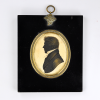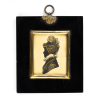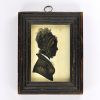Wass, John
Introduction:
McKechnie recorded JOHN WASS a competent minor profilist working a few years either side of 1820 from 76 Cornhill, London. However recent research shows Wass painting profiles as early as 1811 and to have been in turn a cutler, profilist and picture dealer.
His silhouettes are exclusively bust-sized compositions painted on card. Some are given dark gray body colour with gum arabic detailing, others have black body colour overlaid with gilt and Chinese white highlights to accentuate aspects of sitters' attire. Bust lines are of a varying convex-concave termination. Often dated, his profiles are generally signed "by J. Wass 76 Cornhill" on a backing card or backing board. No trade labels are recorded.
Born in Handsworth near Sheffield in 1794, he was the second of 4 children born to Jane née Wrathall (1772-1821) and Sheffield cutler Robert Wass (1770-1851). A sister born in 1796 likely died in infancy but elder brother William (1792-1839) and younger sibling Samuel (1798-1856), after matriculating from Oxford University, were ordained clergymen in 1817 and 1822 respectively.
John Wass's sole profile advertisement appears in 4 issues of the CHELTENHAM CHRONICLE in July 1811. At the time, he was 17 and William 19 years old. A boastful notice related "Messrs W. and J. Wass propose to take likenesses in profile...in a style superior to any brought before the public...".
Brought too was "...a rich assortment of fine cutlery..." manufactured by their father Robert Wass. Mention is also made of his patent razor "patronised by the Prince Regent" on which, if purchased, the brothers Wass proposed to engrave "names and curious ornamental devices".
Some time between 1812 and 1813, Robert Wass relocated both family and business to London. Eldest son William married there in January 1813, and John Wass wed Mary Ann Senior (1793-1868), daughter of a Sheffield hosier at St. Luke's, Finsbury in May 1814.
An October 1814 fire insurance policy and POST OFFICE Directory of the following year record Robert Wass a "Perfumer and Cutler" of 12 Cheapside. By happenstance the address also housed miniature painter and profilist Henry Hervé (1783-1853). Given their proximity, Hervé and John Wass surely had contact, though whether the versatile Hervé influenced Wass in any form is unknown.
From 1815 POST OFFICE Directories evidence Robert Wass renting a second shop at 76 Cornhill. Likely John Wass managed it, as when his first child Eliza Senior (1815-1860) was baptised in October 1815, the St. Michael's Cornhill register records his abode as 'Cornhill' and his occupation as 'Cutler'.
The outlet at 12 Cheapside disappears from directories in 1818. In December 1819, two advertisements in the MORNING CHRONICLE relate Robert Wass to be "...retiring from the retail business..." and auctioning off a substantial stock in trade from 76 Cornhill. However, directories record him still trading there in 1824 along with son John who is listed between 1821-1824 as a "Portrait Painter".
By the winter of 1824, both father and son had removed from 76 Cornhill. A MORNING CHRONICLE advertisement of the 8th of December records John Wass, now with a Holborn address, acting as agent for the sale of "Christ Entering Into Jerusalem" by Benjamin Robert Haydon (1784-1846). Exhibited at 27-28 Cornhill, the painting never sold.
For Wass at least it appears to have been a minor setback. Likely he was already acquiring, perhaps via Haydon, connections in the art market. By March 1827, when his last child Emily Jane (1827-1915) is baptised, Wass listed his occupation as "Picture Dealer".
As an art dealer he appeared to be in the right place at the right time. As the newly monied middle class with a will to acquire, but no knowledge of the art market rose, so too did the number of dealers acting as informed agents. To quote Leonard Robinson's biography of artist William Etty, the "...serious business of dealing began in London in the 1820s".
Seemingly successful, by 1826 he'd moved to a sizable newly-built property in the then largely rural district of Kentish Town, and in 1830 was listed in ROBSONS Directory as dealing from the highly fashionable Quadrant, Regent Street. His surviving son, Charles Wentworth Wass (1817-1905) would, with variable success, also become a picture dealer.
John Wass's own success terminated with his early demise. Likely already ill, signing his will on the 17th of September 1832, he died 12 days later. Buried aged 38 on October the 3rd, he joined his mother Jane and his infant son George Robert already in the grave at St. Johns, Hackney, Middlesex.
On the 18th of April 1833, the MORNING HERALD advertised a list of his paintings, prints, bronzes and clocks to be auctioned for the "...relief of wife and family".
Revised 16 April 2023 (Brian Wellings)
Additional research about John Wass:
Source: McKechnie (Author of, British Silhouette Artists and their Work 1760-1860)
Wass, John (McKechnie Section 2)Source: Joll (Hon. Secretary of the Silhouette Collectors Club and Editor of the Club's newsletter)
Wass, John (SCC Newsletter April 2010)


